[/caption]
NASA’s revolutionary Dawn Asteroid Orbiter has begun the final approach phase to the giant asteroid Vesta and snapped its first science image. The image was taken on May 3, when Dawn was approximately 1.21 million kilometers (752,000 miles) distant from Vesta using the science imager known as the Framing Camera.
Besides the pure delight of seeing Vesta up close for the first time, the images play a crucial role in navigating Dawn precisely through space and successfully achieve orbit around the protoplanet that nearly formed into a full fledged planet.
Vesta is the second most massive object in the Asteroid Belt and is 530 kilometers (330 miles) in diameter.
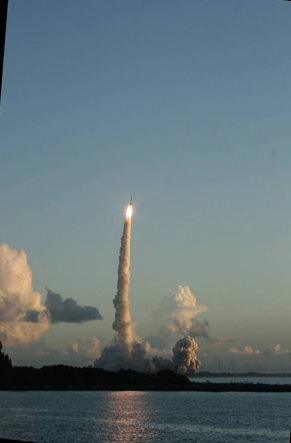
Dawn should be captured into orbit about Vesta around July 16 as the engineering team works to maneuver the spacecraft to match the asteroids path around the sun using the exotic ion thrusters. Using the background stars in the framing camera images, they will be able to determine Dawn’s location in space relative to the stars in order to precisely navigate the spacecrafts trajectory towards Vesta.
“After plying the seas of space for more than a billion miles, the Dawn team finally spotted its target,” said Carol Raymond, Dawn’s deputy principal investigator at NASA’s Jet Propulsion Laboratory in Pasadena, Calif. “This first image hints of detailed portraits to come from Dawn’s upcoming visit.”
The best images of Vesta to date were taken by the Hubble Space Telescope. Jim Adams, Deputy Director of Planetary Science, told me that the images from Dawn’s Framing Camera will exceed those from Hubble in a few weeks.
Dawn will initially enter a highly elliptical polar orbit around Vesta and start collecting science data in August from an altitude of approximately 1,700 miles (2,700 kilometers). The orbit will be lowered in stages to collect high resolution data as Dawn spends about a year collecting data from its three science instruments.
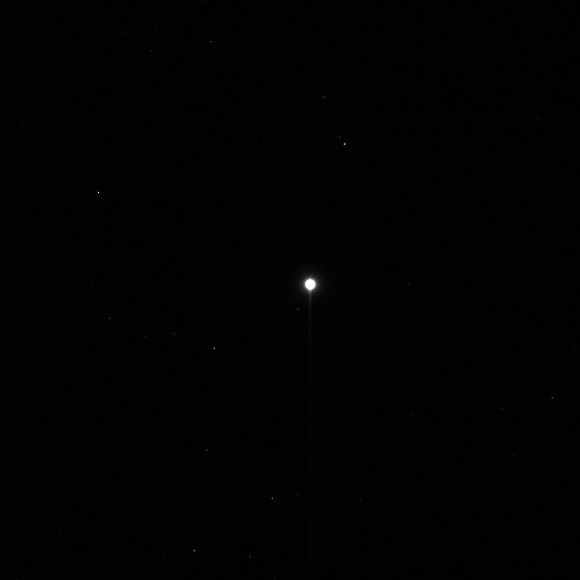
This image shows the first, unprocessed image obtained by NASA's Dawn spacecraft of the giant asteroid Vesta in front of a background of stars. It was obtained by Dawn's framing camera on May 3, 2011, from a distance of about 1.2 million kilometers (750,000 miles). Vesta is inside the white glow at the center of the image. The giant asteroid reflects so much sunlight that its size is dramatically exaggerated at this exposure. Image credit: NASA/JPL-Caltech/UCLA/MPS/DLR/IDA
Thereafter Dawn will be targeted to Ceres, the largest object in the Asteroid Belt which it will reach in 2015.
Dawn is an international mission.
The framing cameras have been developed and built under the leadership of the Max Planck Institute for Solar System Research, Katlenburg-Lindau, Germany, with significant contributions by the German Aerospace Center (DLR) Institute of Planetary Research, Berlin, and in coordination with the Institute of Computer and Communication Network Engineering, Braunschweig. The framing camera project is funded by the Max Planck Society, DLR, and NASA.
The Visible and Infrared mapping camera was provided by the Italian Space Agency. The Gamma Ray Detector was supplied by Los Alamos National Labotatory.
Read more about Dawn in my prior story:
Revolutionary Dawn Closing in on Asteroid Vesta with Opened Eyes
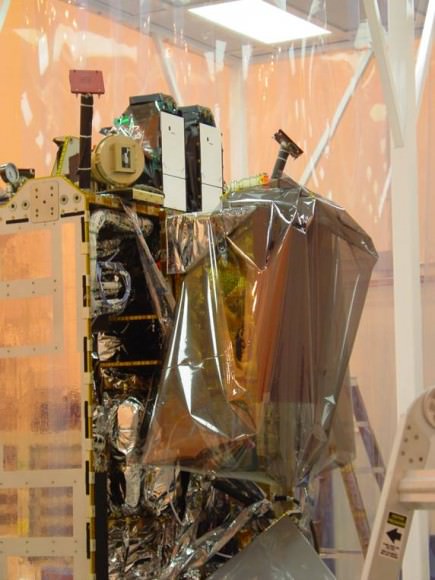

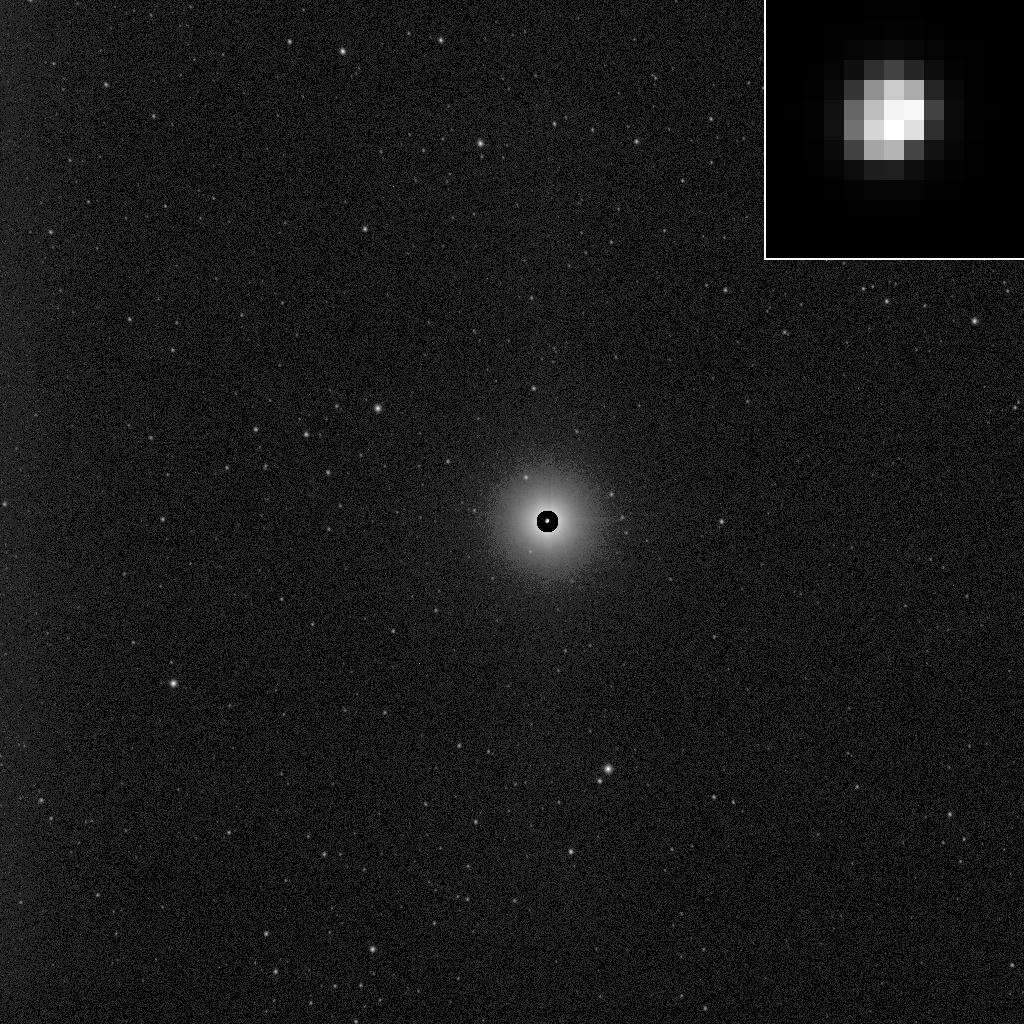
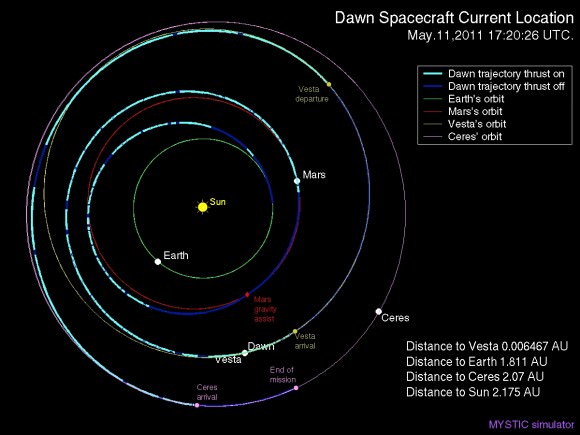
…counting the days to the encounter.
At least Ceres is round, but there is no sign of a hazardous satellite (as yet.)
[This is the reason they masked the star, BTW.]
This is not true. As I write this, no moon search has occurred.
As stated in the 2nd paragraph of this article, these images are for navigation purposes, to ensure the spacecraft is on the correct trajectory.
If you read the image description for the first image, it will tell you the image is processed, from images taken with two exposure times.
So, what has been masked is the overexposed Vesta from longer exposure images. The dot in the centre of the “ring” is Vesta, taken from shorter exposure images. The reason for the longer exposure images is to image the background stars (as stated in the description), for navigation.
As said by NASA press release “Dawn Reaches Milestone Approaching Asteroid Vesta”
“Scientists will search the framing camera images for possible moons around Vesta. None of the images from ground-based and Earth-orbiting telescopes have seen any moons, but Dawn will give scientists much more detailed images to determine whether small objects have gone undiscovered.”
The reason there are two images, is that any movement of a possible satellite would show motion by displacement.
You can find lots of others views that affirm this is also the case.
Thanks for the comments Mr. Hall, but I think you are very mistaken here.
At this point, all I can tell you is that I know what you are saying is wrong. These images were taken for OpNav, and released to the public purely to show that Dawn is almost there. Long exposure images for stars, short exposure images to see Vesta. Composite produced for publicity.
How is it possible to go into orbit around such a small object, especially when Dawn is moving so fast? Does this thing have enough gravity to keep hold of Dawn, or does Dawn have to keep thrusters going periodically to stay in orbit?
At this point in it’s trajectory the velocity of DAWN isn’t that much different from Vesta. Vesta is 750,000 miles away and they’re still 2 months away from going into orbit. That’s only 520 MPH relative to Vesta.
DAWN is slowly catching up to Vesta from behind and if it slows down enough Vesta’s gravity will capture DAWN and it will go into orbit around Vesta. The thrusters are being used to adjust DAWN’s velocity and trajectory so that the capture can take place.
Once DAWN is in orbit around Vesta they will only need to use the thrusters to adjust the orbit so that they can get different views of Vesta. As long as DAWN’s velocity isn’t too high it will remain in orbit.
The size of the object is irrelevant. As long as you’re moving at the right speed you can orbit any object no matter how small.
Could I jump off this thing and go into orbit? The gravity must be a fraction of the Earth’s.
That would be tough. Vesta is actually pretty ‘heavy’, by human standards, with a mass of around 2.67 million billion tonnes (2.67×10^20 kg from wikipedia). I calculated the velocity you need to enter an orbit 10km above Vesta to be around 60m/s. Around 135mph. I certainly can’t move that fast.
As David points out Dawn is only doing around 520mph relative to Vesta so the change in velocity needed to orbit is pretty small.
It’s amazing how this science stuff works out.
I agree that 135mph is pretty fast (I think I can sprint at around 30kmh over brief sections), but the gravity is so much lower on Vesta that your running speed could be much faster, although presumably it would still be much lower than the 135mph you’d need and you’d be weighed down by a space suit of some sort..
No, again, Vesta is pretty big. Referring to my other reply, fifty thousand Mt Everests would (crunched up, more or less) fit inside it. Comparing some numbers on Wikipedia, its cross-sectional area is comparable to Colorado.
It is much smaller than Earth, but getting to Earth orbit requires a skyscraper-sized rocket.
There are asteroids where you could jump into orbit. You would need to:
– Jump from the highest point to avoid crashing somewhere else.
– Push yourself horizontally, so it would be more like scooting than jumping — hand-foot coordination may be key. Too much vertical thrust results in an elliptical orbit which will intersect the surface somewhere else.
– Tuck your arms and legs to avoid an accidental soft landing where you started. This implies that arms and legs must be extended (i.e. hands and knees) at “launch.” Hmm, Superman posture would also work.
Think of Saint-Exupery’s Little Prince. A scale of a kilometer or less should do it. The real limiting factor is the lack of human quadruped coordination. It’s hard to say offhand how much power could be developed in the legs vs the arms. Also, it would take a lot of practice to avoid unintended spin. Precision, not power, is key. Don’t expect unassisted orbital speed to approach that of running on Earth.
Well… those are my thoughts, for what they are worth ;v) .
“The size of the object is irrelevant. As long as you’re moving at the right speed you can orbit any object no matter how small. ”
That’s generally true, certainly for Vesta’s case. But for a small object (say a space shuttle) close to a larger object (say the earth) the volume of space where the small object’s gravitational field is dominant is so small that it actually lies within the physical limits of the smaller object.
So you can’t orbit the space shuttle while it’s in orbit.
At last !! I adore how with a budget as low as that of Dawn they could make extraordinary science :p
is it gonna hit us? if so, i know a lot about electromagnetic propulsion, and that thing has a huge iron deposit!!! if i can get a focused blast, i can send it away and its spiral will go to the sun!